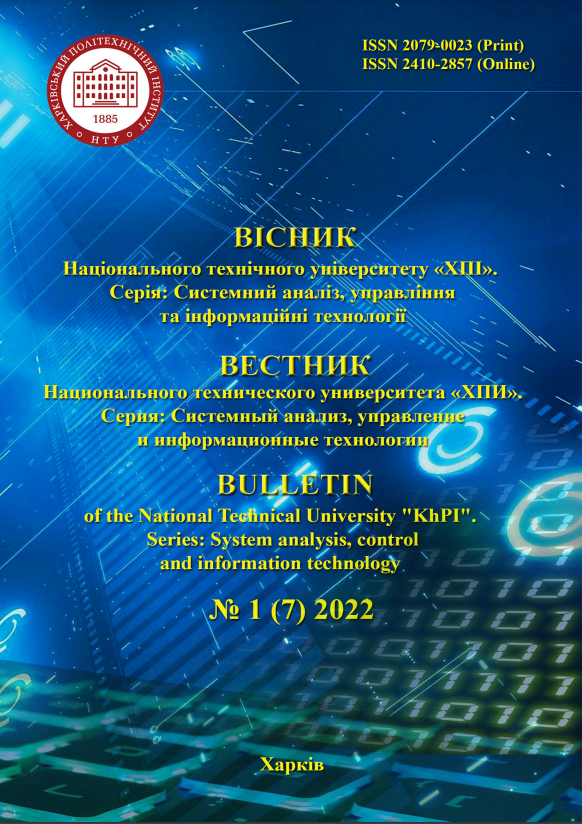RELATIONAL-TEMPORAL MODEL OF SET OF SUBSTANCES OF SUBJECT AREA FOR THE PROCESS OF SOLUTION FORMATION IN INTELLECTUAL INFORMATION SYSTEMS
DOI:
https://doi.org/10.20998/2079-0023.2022.01.14Keywords:
explanation, intelligent information system, temporal dependencies; causality, cause-and-effect relationshipsAbstract
The subject of research is the processes of formation of causal relationships between the states of the entities of the subject area in the process of functioning of the information system. These causal links reflect the dependencies that underlie the process of obtaining a result in the information system, and therefore they can be used to form explanations for this process. The explanation reflects the knowledge of the causes and consequences of both the result obtained as a whole and the individual actions of the decision-making process in the information system. The use of such knowledge increases the user’s confidence in the decisions received from the information system. The aim of the work is to develop a relational-temporal model of representation of many interconnected entities of the subject area, which are the object of decision formation in the information system, in order to create conditions for identifying causal dependencies on the decision formation process in such a system. To achieve the formulated goal, the following tasks are solved: structuring the relationships between the entities of the subject area in the attributive and temporal aspects; determining constraints on the decision-making process in the information system based on static dependencies between entities; definition of temporal connections within one class of entities as a reflection of causal dependencies between entities in the process of obtaining a solution in the intellectual system; construction of a relational-temporal model of interconnected entities of the subject area. Conclusions. The structuring of static and dynamic dependences between the entities of the subject area, which is the object of decision formation in the information system. Static constraints on the process of decision formation, which are related to the properties of the subject area, are determined. The temporal dependences between the entities of the subject area are determined, which reflect the cause-and-effect relations between the actions of the decision-making process. A relational-temporal model of related entities of the subject area is proposed, which contains classes of entity equivalence, static dependencies between properties of different equivalence classes, as well as temporal dependencies between properties within each class. The model makes it possible to test constraints on the decision-making process based on static relationships between entities of the subject area, as well as to determine possible sequences of changing properties of entities over time, which creates conditions for building causal relationships that underlie the decision-making process. The obtained causal dependencies are a key element of explanations about the process of functioning of the information system.
References
Gunning D., Aha D. DARPA’s Explainable Artificial Intelligence (XAI) Program. AI Magazine. 2019. no 40(2), pp. 44-58.
Engelbrecht Andries P. Computational Intelligence: An Introduction. NJ: John Wiley & Sons, 2007. 632 р.
Swartout W., Moore J. Explanation in Second Generation Expert Systems. David J-M., Krivine J-P., Simmons R. (ed) Second generation expert systems, Springer-Verlag. 1993, pp. 543-585.
Lewis D. Counterfactual Dependence and Time’s Arrow. Counterfactuals and Laws. 1979. Vol. 13, no. 4, pp. 455-476.
Paul L. A., Hall. N. Causation: A User’s Guide. Oxford: Oxford University Press, 2013. 259 p.
Lewis D. Causation. Journal of Philosophy. 1973, no 70 (17), pp. 556-567.
Halpern J. Y. Axiomatizing causal reasoning. Journal of Articial Intelligence Research. 2000, no 12, pp. 317-337.
Halpern J. Y., Pearl J. Causes and explanations: A structural-model approach. Part II: Explanations. The British Journal for the Philosophy of Science. 2005, 56 (4), pp. 889-911.
Miller D. T., Gunasegaram S. Temporal order and the perceived mutability of events: Implications for blame assignment. Journal of personality and social psychology. 1990, no 59 (6), pp. 1111-1118.
Chalyi S., Leshchynskyi V. Temporal representation of causality in the construction of explanations in intelligent systems. Advanced Information Systems. 2020, vol. 4, no 3, pp. 113-117.
Chalyi S., Leshchynskyi V., Leshchynska I. Deklaratyvnotemporalnyi pidkhid do pobudovy poiasnen v intelektualnykh informatsiinykh systemakh [Declarative-temporal approach to the construction of explanations in intelligent information systems]. Visnyk Nats. tekhn. un-tu "KhPI": zb. nauk. pr. Temat. vyp. Systemnyi analiz, upravlinnia ta informatsiini tekhnolohii [Bulletin of the National Technical University "KhPI": a collection of scientific papers. Thematic issue: System analysis, management and information technology]. Kharkov, NTU "KhPI" Publ, 2020, no. 2(4), pp. 51-56.
Pearl J. Causality: models, reasoning and inference. Cambridge University Press, USA. 2009, no. 2.
Halpern J. Y., Pearl J. Causes and explanations: A structural-model approach. Part I: Causes. The British Journal for the Philosophy of Science. 2005, no. 56 (4), pp. 843-887.
Maier M., Marazopoulou K., Jensen D. Reasoning about Independence. Probabilistic Models of Relational Data. 2014.
Marazopoulou K., Maier M., and Jensen D. Learning the structure of causal models with relational and temporal dependence. Proceedings of the Thirty-First Conference on Uncertainty in Articial Intelligence. 2015.
Downloads
Published
How to Cite
Issue
Section
License
LicenseAuthors who publish with this journal agree to the following terms:
- Authors retain copyright and grant the journal right of first publication with the work simultaneously licensed under a Creative Commons Attribution License that allows others to share the work with an acknowledgement of the work's authorship and initial publication in this journal.
- Authors are able to enter into separate, additional contractual arrangements for the non-exclusive distribution of the journal's published version of the work (e.g., post it to an institutional repository or publish it in a book), with an acknowledgement of its initial publication in this journal.
- Authors are permitted and encouraged to post their work online (e.g., in institutional repositories or on their website) prior to and during the submission process, as it can lead to productive exchanges, as well as earlier and greater citation of published work (See The Effect of Open Access).


